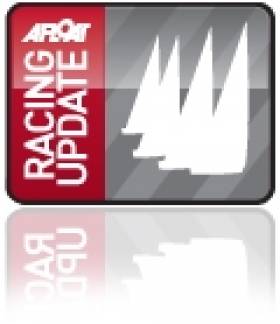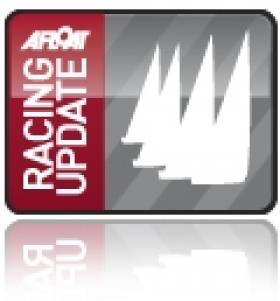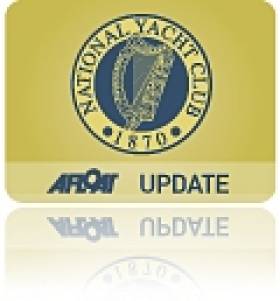Displaying items by tag: Ruffian
Joint Award Presented to National Yacht Club and Ruffian Association at MG Sailing Club of the Year Ceremony
The prestigious MG Sailing Club of the Year Ship's Wheel was awarded to both the National Yacht Club and the Ruffian Association at a presentation ceremony at Dun Laoghaire Harbour on Thursday evening, February 29th.
As Afloat's WM Nixon announced in early January, the joint award to the club and class 'perfectly expressed the overall mood of all that is best in Irish sailing as the 2024 sailing season begins'.
The event was attended by many NYC Olympians, world champions, and cruising achievers, many of whom received 15 premier awards at the club achievement awards ceremony just a week ago.
During the tea time presentation, Commodore Peter Sherry expressed his gratitude and pride in the spirit and community that underpinned everything the National YC and its members achieved in 2023 and was 'delighted' to have been honoured with the Ruffian 23s.
The presentation was a pre-2024 sailing season high for the Dublin Bay club and class and something the club cherishes, according to Sherry.
Heather Kennedy, the daughter of the Ruffian 23 designer and builder Billy Brown, travelled from Strangford Lough to be present at the ceremony. She gave a brief history of the class, which celebrated its golden anniversary in 2023.
Afloat's W M Nixon will review the award and the night's celebrations in full in his Sailing on Saturday blog tomorrow (March 2) here.
UK Sailmakers Ireland congratulates Ann Kirwan and the crew of Bandit for its weekend win of the Ruffian 23 Nationals 2021 on Dublin Bay.
Taking six first places and two seconds over the three-day championship, Bandit's performance speaks for itself.
All Bandit's racing sails are the latest UK sailmakers designs, a massive upgrade in construction and design arising from years of development in the Ruffian class.
 All Bandit's racing sails are the latest UK sailmakers designs
All Bandit's racing sails are the latest UK sailmakers designs
Bandit's new designed S2 spinnaker allows her to reach and run faster. This, combined with her UK Sailmakers Genoa 1 max size and new main design and excellent crewing work, gave Bandit the championship win this weekend.
 Commodore Martin McCarthy of the National Yacht Club presents Bandit skipper Ann Kirwan with the Ruffian 23 National Championship trophy
Commodore Martin McCarthy of the National Yacht Club presents Bandit skipper Ann Kirwan with the Ruffian 23 National Championship trophy
Contact UK Sailmakers Ireland for more details.
#ruffian23 – Diane skippered by Chris Helme of the host club was the winner of a 16–boat Ruffian 23 National Championhips at the Royal St. George Yacht Club at the weekend. Entries were largely Dublin Bay based but also included regular visitors from Belast Lough.
Race Officer Colin McMullen, assisted by Suzanne McGarry and the race team aboard Albanita, kicked off with a windward leeward race on Friday evening. Trevor Kirkpatrick, commodore of Carrickfergus Sailing Club sailing Carrageen, sailed a faultless race leading the 16 boat fleet from the start and getting the gun ahead of Frank Bradley's Ripples (DMYC), with holder Chris Helme's Diane II (RStGYC) 3rd.
A second race saw very light winds and just 8 boats finishing inside the 2 hour time limit. Again Carrageen took the gun with Rob Sastre's Paramour (NYC) in 2nd, and Chris Helme's Diane II finishing 3rd.
Three races were held on Saturday in a 12-15kt breeze. Diane II won the first race with Carrageen 2nd. The second race saw Carrageen getting her third gun of the series with Diane II finding herself the wrong side of a wind shift and finishing 11th. Saturday's final race resulted in a win for Diane II with Carrageen 2nd.
Going into the final day Carrageen had 5 points after discarding a 2nd – counting three 1sts and a 2nd. Diane II had 8 points after discarding her 11th – counting two 1sts and two 3rds. So Diane II needed two 1sts and needed Carrageen to finish worse than 2nd in both races in order for Diane II to retain the title. The 6th race saw Carrageen leading right up until the finish line where she was just pipped by Diane II and Crescendo (Lorcan Balfe NYC), with Carrageen finishing 3rd.
The last race saw Carrageen failing to recover from a poor start and finishing 7th, while Diane II climbed from 3rd place to 1st, getting her 4th gun of the series and winning the event on count-back from Carrageen.
Ruffian National Champs 2015 at the Royal St. George YC
1 Diane 2 3 3 1 [11] 1 1 1 10
2 Carrageen 1 1 2 1 2 3 [7] 10
3 Paramour [8] 2 6 4 8 4 2 26
4 Shannagh 6 5 5 [10] 3 6 3 28
5 Cresendo 9 4 4 [14] 5 2 6 30
6 Ruffles 7 [DNF] 7 2 4 8 4 32
7 Ripples 2 6 [9] 6 6 5 8 33
8 Bandit 5 [DNF] 3 7 7 7 9 38
9 Alias 4 [DNF] 8 5 9 9 5 40
10 Ruffage 12 8 [13] 8 12 10 10 60
11 Ruff Rider 10 [DNF] 12 3 14 13 11 63
12 Daisy 11 [DNF] 11 9 13 12 13 69
13 Riff Raff 15 [DNF] 10 13 11 11 15 75
14 Ruff Diamond 13 7 14 [DNF] 15 14 12 75
15 Different Drummer [DNS] DNS 15 12 10 DNS DNS 88
16 Ruff n Ready 14 [DNF] DNF DNF DNF 15 14 94
Dickie Brown 1933-2014
Dickie Brown of Portaferry, builder of the Ruffian range of yachts and one of Ireland's most accomplished sailors, has died at the age of 81 after a long and well-lived life. His three abiding passions were his family, his boats and their interaction with the sea, and devoting his working career towards increasing the prosperity and quality of life in his home town of Portaferry.
Portaferry is at the far southern end of the long Ards Peninsula in County Down, set on the east side of the tide-riven Narrows which flow from the Irish Sea into Strangford Lough. The ferry service across the Narrows to Strangford village to maintain the connection with central County Down has not always been the efficient link it is today, and for much of their boyhood the three Brown brothers - Tom, Billy and Dickie – lived in an isolated town which for many was economically deprived.
However, the brothers were able to break away from the limitations of small town life. Tommy followed a career in law which resulted in his becoming Sir Thomas Brown, while Billy – after service in World War II flying from aircraft carriers with the Royal Navy - became a university lecturer in physics, electronics and engineering. But Dickie – after various youthful adventures – was determined to be Portaferry-based, and his brothers were to back him in his boat-building project with Weatherly Yachts, for which Billy was the successful designer.
It was only after considerable experience in sailing and other areas of business that they felt sufficiently confident to set up the firm. In his younger days, Billy had become the owner of the Marie Michon, a notably hefty 28ft gaff cutter based on the Falmouth Working boat type. It was on this boat that Dickie had his first seagoing experience, so it was intriguing that when he decided to get a boat of his own inclinations in partnership with Billy in 1962, he went in completely the opposite direction, and settled on Black Soo, a 1957-built ultra-light Van de Stadt-designed 30ft offshore racing cutter of very minimal accommodation.

She was just a slip of a boat. Dickie Brown working on the topsides of Black Soo at Portaferry pier in 1964. Photo: W M Nixon
He bought the boat through her builders, Bob and Wally Clark of Cowes, thereby forming another of many lifelong friendships through which he learned much about the ways and means of running a boat-building operation and surviving in the marine industry. When Black Soo appeared for the first time in the decidedly conservative setting of Northern Ireland sailing 52 years ago, she looked sensationally different to anything else on the growing local offshore racing scene. But she successfully came through the gale-tossed first RUYC Ailsa Craig Race of 1962, and in 1963 she won it overall, going on through the mid 1960s to cut a swathe through fleets on both sides of the North Channel and in the Irish Sea, with a sensationally-fast performance in any heavy weather offwind sailing.
By 1967 Dickie had done his first Fastnet Race as a crewman, and after his second in 1969 he decided to build himself a 35-footer to his own ideas with the design created by brother Billy, who by this time had moved back to live in Portaferry and raise a family. Billy was to find that he did his best yacht design work after about three o'clock in the morning, "when the air isn't cluttered by other people thoughts".
Dickie meanwhile had married Joyce, a talented New Zealand artist, and they'd built themselves a house on the side of Bankmore Hill, right above the narrowest part of the Narrows and looking north into Strangford Lough. At the bottom of the field which now became the garden, a shed went up. It was originally planned as a pig house, as agricultural production was one of Dickie's many business interests. But soon the pigs were out, and the hull of a 35-footer started to appear instead, built upside down in three glued skins of diagonal planking and superbly constructed, for Dickie was a natural craftsman in wood.
Thus was Ruffian created, and it was a wonderful day in the early summer of 1971 when she was launched for the first time in a carnival family and community effort, the day going so smoothly, with successful afternoon sailing trials, that Joyce was moved to create a watercolour of it all, and that picture can still be seen in Portaferry today.
Ruffian made an impressive debut during 1971, but it was 1972 which saw her at her best on the offshore scene at home and abroad, winning practically everything she took part in. Yet she was already for sale, as the genesis of Weatherly Yachts was well under way, and in March 1973 the prototype of the GRP Ruffian 23, designed in Portaferry, built in Portaferry, and first sailed in Portaferry, made her successful debut.
The Ruffian 23 was the right boat at the right time. Local offshore racing was developing at many centres, and the able and attractive little performance sailer found ready buyers at home and abroad. At the height of its success, the Ruffian 23 was to be found in varying and often substantial numbers in places as widespread as Belfast Lough, Strangford Lough, Dublin Bay, the Isle of Man, Scotland, northwest England, Iceland and Hong Kong.

The prototype Ruffian 23 on her maiden sail, March 1973. Photo: W M Nixon
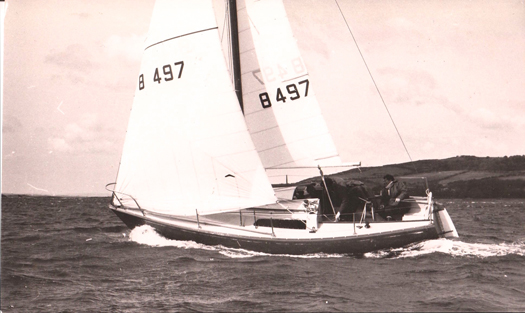
The right boat in the right place at the right time in 1973. The gallant little Ruffian 23 attracted adherents worldwide, and continues to race as a class in Dublin Bay and at Carrickfergus. Photo: W M Nixon
Today the class is still to be actively found in Dublin Bay and at Carrickfergus. But racing inshore and offshore wasn't the only area of success, Ruffian 23s were also cruised extensively with round Ireland ventures, and voyages to distant exposed islands such as St Kilda, satisfyingly completed. The Ruffian 23 sailors formed a maritime brotherhood (and sisterhood) which many maintain to this day, even when they have moved on to larger craft.
Weatherly Yachts also moved on to larger models, while maintaining a steady production of Ruffian 23s to provide good work in that former unemployment blackspot. New ventures included the 30ft Half Tonner Rock'n Goose (it's the local pronunciation for Rock Angus, the lighthouse-topped reef in the Narrows) which took part in the Half Ton Worlds at La Rochelle in France in 1974, and came through unscathed from a 180 degree roll in a huge Biscay storm, her survival in good order a credit to Dickie's boat-building skills. But for the next boat up in their range, Weatherly eventually settled on the 28ft Ruffian 8.5, which achieved success in a variety of ways, not least in the late Mike Balmforth's Sgeir Ban, which was fractionally-rigged to give a potent performance, and also proved herself as a very able cruiser on the Scottish and Irish coasts.
When the going was good for Weatherly Yachts of Portaferry, it was very good. But the increasing dominance of large often government-backed Continental companies in the mass-production boat-building industry meant that the longterm prospects for a small family firm in a remote location were increasingly negative. In fact, looking back, we can now realize that the Brown brothers with Weatherly Yachts hit the ground running with good ideas and a keen workforce just at the one juncture when a business with this scale and location could succeed, and they made the very best of the opportunity to provide a golden era for Portaferry.
With the firm quietly closing down after a gallant effort, Dickie was able to return to other business interests and his first love afloat – classic wooden yachts. His boat for the final long phase of his life was very different from the boisterous little plastic Ruffians, as it was the exquisite teak-built Arthur Robb-designed 42-footer Jaynor, which Dickie as a young man had watched being meticulously built by Bruce Cowley in Bangor Shipyard on the shores of Ballyholme Bay in the early 1960s.
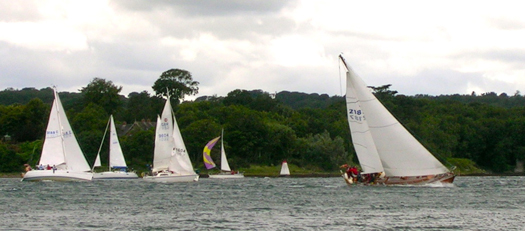
The classic yacht for a senior sailor. Jaynor with Dickie Brown at the helm storms into the lead at a breezy Portaferry Regatta. Photo: James Nixon
Dickie Brown and his family and friends with Jaynor became a familiar sight at classic events at home and abroad, but always his first love was to be sailing from Portaferry on the waters with which he'd been engaged all his life. Eventually, ill health meant Jaynor had to be sold, but even despite his infirmities, Dickie was still able – in his 80th year – to take part and finish in the Golden Jubilee Ailsa Craig Race in 2012, one of the very few who had done the same in the first race of 1962.
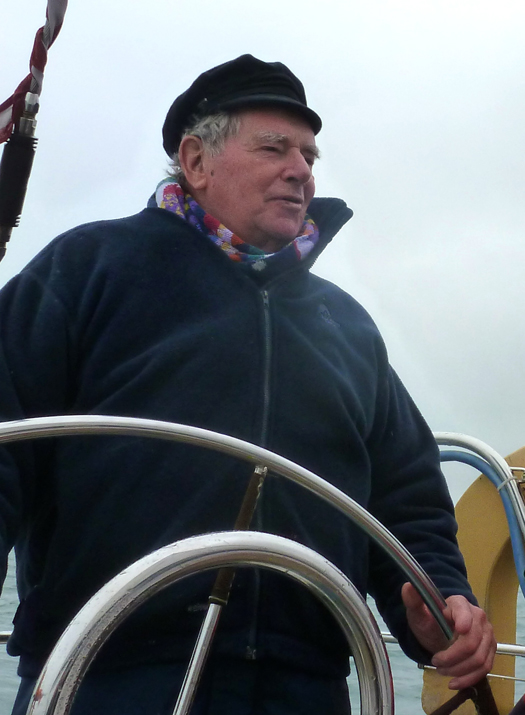
The lifelong enthusiast. Dickie Brown at the helm at the finish of the Golden Jubilee RUYC Ailsa Craig Race in 2012. He regularly sailed in the race from its inception in 1962, and was overall winner with Black Soo in 1963. Photo: W M Nixon
Now into his eighties, and with grandchildren to cherish, his interest in boats and his home waters never diminished, and he had many friends to help him get afloat. My own last sight of him out in a boat was just last year. We were coming in to Strangford Narrows with the new flood, and there was a useful little fishing launch bobbing about on the bar, having come down with the last of the ebb to take advantage of any good fish coming in on the new tide.
As we shaped on our course into the Narrows, the little boat completed her brief but successful task and started to head home to Portaferry, motoring alongside us for a while to say hello. It was Dickie and some friends, in good form and out for a spot of neatly-timed fishing before Sunday lunch.
It was a moment to treasure, a good way to remember a great man of the sea and the coast, a man who enriched the lives of all who knew him. Our thoughts are with Joyce, and Richie, Fraser (a former Olympic sailor for Ireland in 2004) and Karen and the grandchildren at this sad time.
WMN
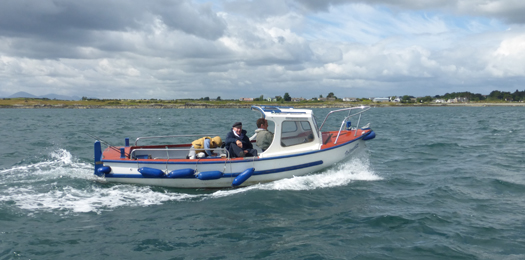
A last sight of Dickie Brown afloat on his home waters. It's August 2013, and with some friends he has come down through Strangford Narrows with the last of the ebb for some useful fishing on the bar, and is now returning to Portaferry with the new flood, nicely on time for Sunday lunch. Photo: W M Nixon
Ireland's Oldest Wooden Boats Aren't Getting Any Younger
#woodenboats – On Midsummer's Day, W M Nixon looks back on the already busy and event-filled Irish season of 2014, and reflects on the extraordinary longevity of some boats, their remarkable variety, and the diverse characters who own them.
When I shipped aboard the former Bristol Channel Pilot cutter Madcap to sail the Old Gaffers Division in Howth Yacht Club's Lambay Race on June 7th, it wasn't the first time I'd been out and about on a boat built in the 1870s. But as most of my experiences on John and Sandra Lefroy's 1873-vintage iron-built classic 58ft Victorian steam yacht Phoenix on Lough Derg took place in the 1970s with the most recent jaunt being way back in 1982, sailing on the Madcap was indeed the first time afloat in a boat built 140 years ago.
It takes an effort to get your head around the most basic notion of such an age. You find yourself reflecting on the delights that still awaited the human race at the time, things that were still far into the remote future in the 20th Century. During the 1870s, industrialisation was still gaining traction, but the very idea of warfare on the industrial scale which was to be experienced in the Great War of 1914-18 was beyond most people's imagination, and way beyond anyone's experience. That said, there were more than enough other ways of experiencing an early death, with a range of particularly unpleasant illnesses which have been largely eliminated today.
Yet it was increasing industrialisation which created the circumstances that enabled both boats to be built. The Bristol Channel Pilot cutters evolved rapidly in the latter half of the 19th Century in order to provide pilots for the more numerous and increasingly large ships which were coming into ports such as Cardiff and Bristol. They reached their peak of performance around 1900, by which time they'd achieved a remarkable stage of development, being fast and able, yet comfortable at sea, and capable of being handled by a very small crew after the pilots had been delivered to incoming vessels. When their working days were over as they were replaced by motorised vessels, they proved ideal as seagoing cruising yachts.
There was nothing work-oriented about the pleasure yacht Phoenix when she was built to the designs of Andrew Horn in Waterford in 1873. Or maybe that's being a bit naïve. After all, she is down as having been built by and for the Malcolmsons of Waterford. They were a remarkable clan who brought many industries to Waterford in the 19th Century, and they created the miniature industrial town of Portlaw westward from the city, off the south bank of the Suir Estuary.
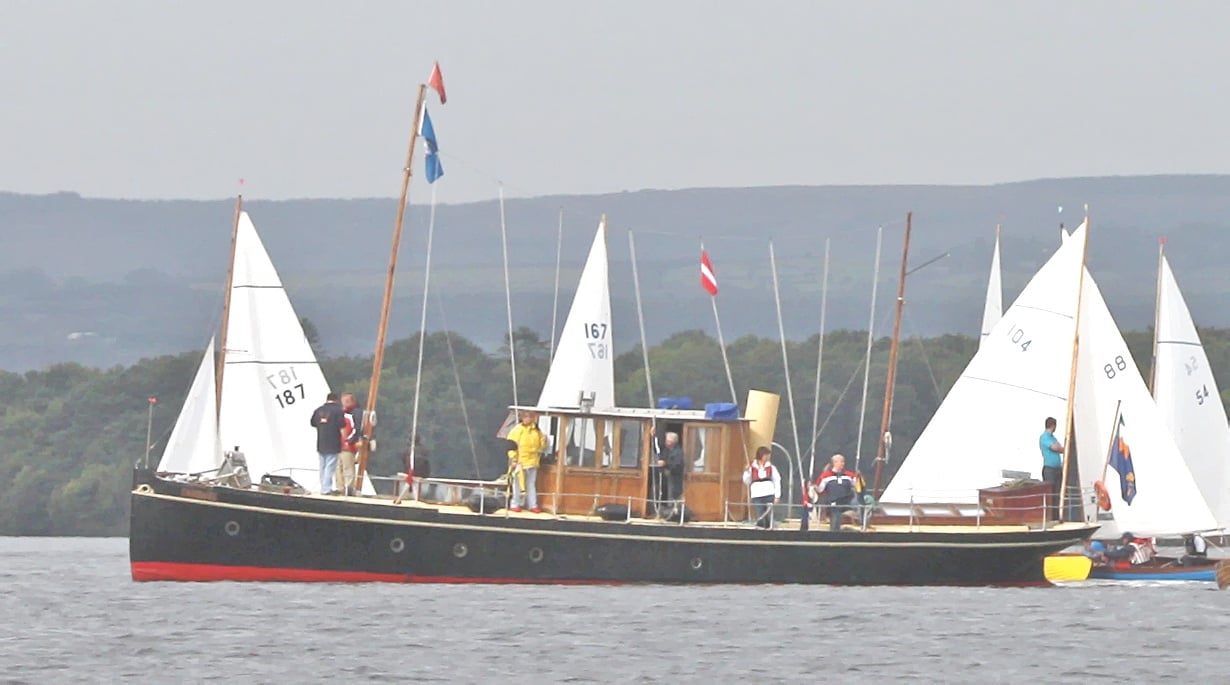
The 58ft Phoenix, iron-built in Waterford in 1873, performing Committee Boat duties at Dromineer for Lough Derg YC. Photo: Gerardine Wisdom
So in building the Phoenix themselves, so to speak, they were creating a subtle advertisement for Waterford expertise, with this new miniature of an ocean liner being constructed in the highly-regarded Lowmoor iron. And she's a powerful statement - this lovely old vessel has lasted much better than many of the Waterford enterprises which outshone her at the time of her building, so much so that if, in Waterford's current recessional woes, they sought something to symbolise what the city is capable of, they would do worse than put some resources the way of the Phoenix for her continuous maintenance.
Five years ago she made a very stylish appearance as the Committee Boat in a classics regatta at Dromineer, and that in turn produced an astonishing photo which included Ian Malcolm's 1898-built Howth 17 Aura. It was the first time a jackyard topsail had been seen on Lough Derg since before the Great War, and all that together with a raft of Shannon One Designs (which date from 1922 onwards) and a fleet of Dublin Bay Water Wags from 1902 onwards meant that the total age of the boat in the photo was pushing towards the 2,000 years mark.

Phoenix and the 1898 Howth 17 Aura (Ian Malcolm) at Dromineer with rafts of Shannon ODs and Water Wags. The combined age of the bots in the photo is well over a thousand years. Photo: Gerardine Wisdom
To be aboard Phoenix is to be transported right back to the 1870s, as she has a beam of only 10.5ft, which on a length of 58.5ft make for one very slim and potent hull. She has long since had her original steam engine replaced with a diesel, and back in 1982 when I was last afloat in her, it was October, and we were the Committee Boat for the annual IYA Helmsmans Championship, raced that year in Shannon One Designs with Dave Cummins of Sutton the winner, crewed by Gordon Maguire.
Being late season, the Phoenix's injectors needed a clean, but as the Race Officers were those perpetual schoolboys Jock Smith and Sam Dix of Malahide, they were delighted by the Phoenix's ability to emit a fine plume of smoke from her funnel at full speed, and after the championship was resolved they tore across the lively waters of Autumnal Lough Derg at full speed while – from another boat - I grabbed some photos which made Phoenix look like a destroyer in action at the Battle of Jutland. One of them subsequently appeared as the cover of Motor Boat & Yachting, and as I seem to have mislaid the colour slides, if anyone has a copy of that particular edition I'd much appreciate a scan of it.
Moving on from the 1873-built Phoenix in 1982 to the 1874-built Madcap in 2014 is quite some saga, but we'll edit it by sticking to events this year revolving around the developing annual Old Gaffer programme in the Irish Sea. Last year Dickie Gomes' 1912-built 36ft John B Kearney yawl Ainmara from Strangford Lough won the inaugural Leinster Trophy race in Dublin Bay which marked the OGA's Golden Jubilee, and she did it despite now being bermuda rigged. But as she was returning to her birthplace in Ringsend for the first time in 90 years, she was treated as an honorary gaffer.
Honour being the theme of things, this meant we were honour-bound to bring her south again to defend the Leinster in 2014, but this was given an added impetus by a plan to link up in Dun Laoghaire with Martin Birch's 1902-built Espanola out of Preston in Lancashire. From 1912 until 1940, the 47ft Espanola was a feature of the Royal Irish YC in Dun Laoghaire, owned by noted sailor Herbert Wright, who in 1929 became the founding Commodore of the Irish Cruising Club when he cruised Espanola with four other yachts to Glengarriff where the ICC was founded on July 13th 1929. The Espanola links, together with the fact that the RIYC is now in partnership with Wicklow Sailing Club in hosting the fleet for the biennial Round Ireland Race, made for a fortuitous combination, as Dickie Gomes of Ainmara was Mr Round Ireland between 1986 and 1993, when he held the open Round Ireland Record and also had been overall winner of the 1988 race.

Espanola as she was in 1929, when Commodore's yacht at the founding of the Irish Cruising Club
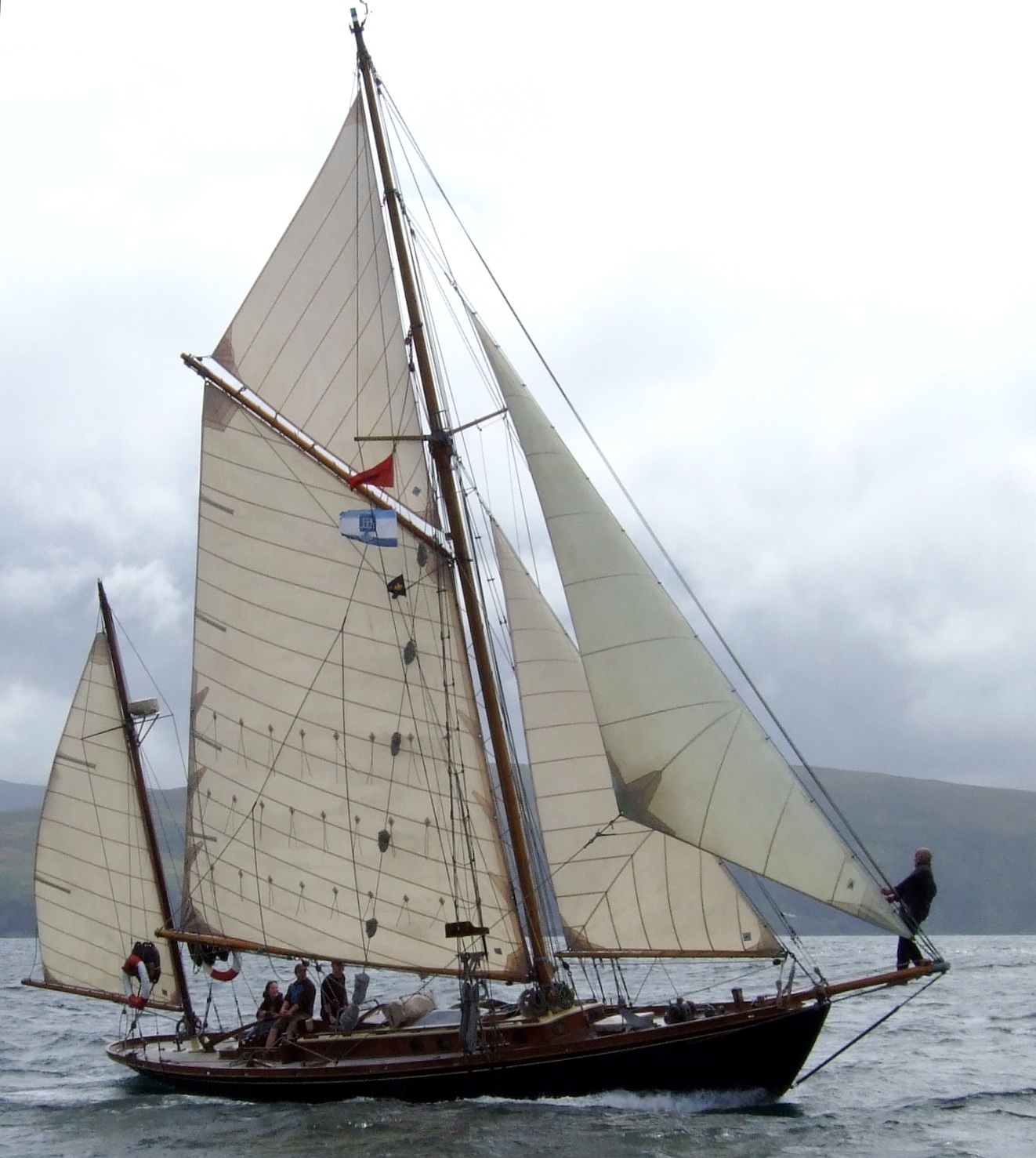
The 1902-built Espanola as she is today
Thus all the stars were in alignment for an historic and convivial meeting of the two old boats at the RIYC on the evening of Friday May 30th, the night before the Leinster Plate race was due to start just round the corner in Scotsmans Bay. But while stars may have been in alignment, ducks failed to get into a row, as Espanola with her exceptional draft of 7ft 6ins failed to get out of Preston over the shallow bar in the one tide which would have suited, on May 16th.
This situation is a useful illustration of the problems the old gaffer people face in keeping the show on the road with limited resources. Martin Birch, having been a lecturer in Lancaster University, had found Preston's little marina an ideal place to keep and maintain Espanola, and the marina in turn regarded the old girl as their pet boat. But Preston is longer a busy commercial port, so the channel has been left to is own devices, and with the huge tides of the Lancashire coast, getting Espanola to sea is quite a challenge as sometimes there's only one day in any month when it can be done.
So there we were, faced with the prospect of Hamlet without the Prince with just ten days to go to the historic gathering at the RIYC. But Jim Horan, affable Commodore of the Royal Irish YC, took it all in his stride and told us to bring Ainmara along anyway, it would be a good excuse for a Friday night party and he was keen to meet the skipper who had made the Round Ireland challenge very much his own 28 years ago.
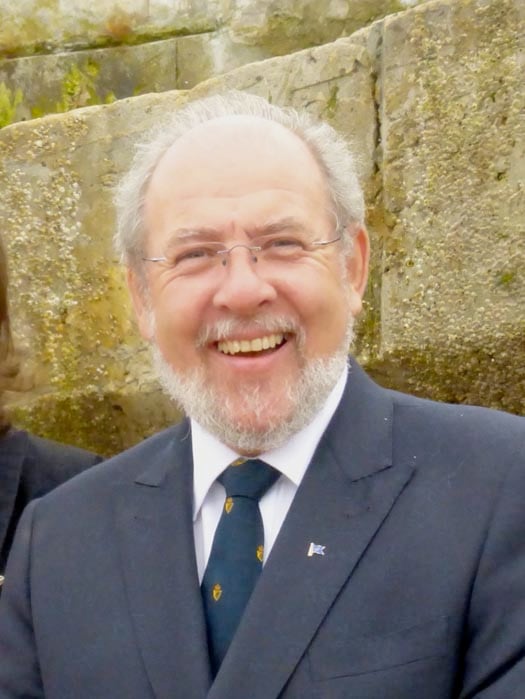
Jim Horan, Commodore of the RIYC, told us to come on and be welcome even though Espanola couldn't make it. Photo: W M Nixon
With the foul weather of mid-May, while Ainmara had got afloat from her winter quarters in a hayshed at the Gomes farm on the Ards peninsula in County Down, further fitting out was difficult in endless rain, and the skipper came down with a massive cold. But then the weather perked up, and he did too, so at lunchtime on Thursday My 29th we headed down Strangford Lough from the Down Cruising Club's former lightship headquarters at Ballydorn to catch the start of the ebb in Strangford Narrows at 1430 hrs.
Progress was good with a light to moderate nor'easter, but Ainmara and her crew (there were four of us – Brian Law, Ed Wheeler and I together with Dickie) have got to the stage where nights at sea are regarded to be the result of bad cruise planning. Yet if we were going to be comfortably in Dun Laoghaire for Friday evening, then only Port Oriel at Clogherhead made sense as an overnight. But Port Oriel, home to some of the best-maintained fishing boats on the coast, can become a very crowded place on a Thursday night.
However, a phone call to the uncrowned king of Clogherhead Aidan Sharkey – whom I'd first met back in the 1980s when our two boats were moored in Seal Hole at Lambay, where he was diving on the nearby 1854 wreck of the Tayleur - ensured there'd be a berth for us, and when we arrived in at sunset there was the man himself to direct us to a corner where we wouldn't inconvenience fishing boats, and moreover had access to a set of proper steps.
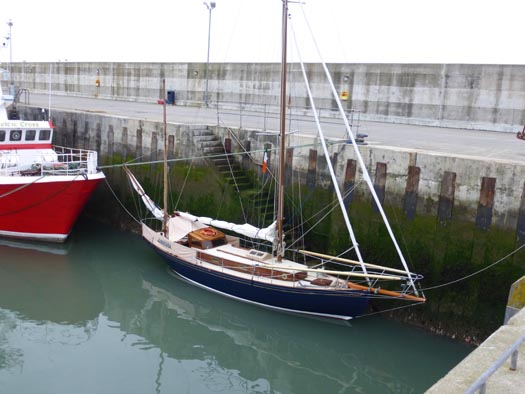
Port Oriel at Clogherhead provided Ainmara wih a handy overnight stop. There was more space available (below) as most of the 30-strong local fleet were away fishing the south coast. Photos: W M Nixon

Aidan's commitment to the maritime life is total. He's of an old Clogherhead fishing family, and he and his late brother Feargal were the backbone of the local beach-launched lifeboat crew. The banter was mighty on board Ainmara, leavened with tales of lifeboat experience which would curl your hair. The laughter through the companionway attracted others board, and soon Sean the razor clam man (all of his catches go straight to China) was in the hatchway with glass in hand, and when we asked where we might get a new deck scrub first thing in the morning as somehow the ship's own one had gone AWOL, Sean said not to worry, he'd throw one on board, and we could just leave it on the big fishing boat beside us as we left next day.
Ashore, I went up to Aidan's house in the village as he'd said he'd something to show me, which was an understatement. He was into the diving much earlier than most, thus when he got to wrecks which today are known to everyone, there were still intact bits of the cargo to be salvaged. Most east coast divers have fragments of chinaware, pottery and other artefacts from the Tayleur, but Sean had so many complete pieces, together with many other items of special antique value from other wrecks mostly in Donegal, that he would be well able to provide complete afternoon tea for the entire choir, all served on 1840s china. But it wasn't tea I got in the Sharkey household, it was Aidan's present of a large bag of fresh crab claws, and a selection of his own-cured salmon – smoked and gravid lax both – which sustained us through the next day's sail.
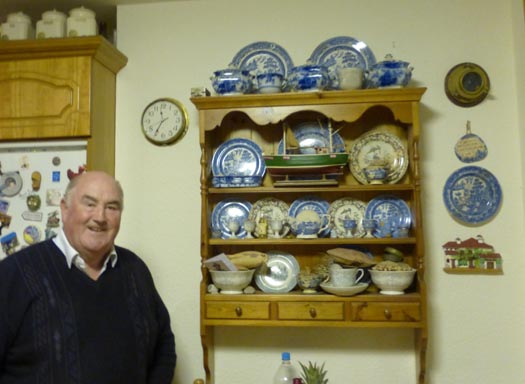
Aidan Sharkey of Clogherhead with some of his remarkable collection of salvaged chinaware. Photo: W M Nixon

The sort of sailing cruising folk dream of. Ainmara shaping up nicely to take the first of the fair tide through the islands at Skerries. Photo: W M Nixon
The morning brought the welcome gift of a decent little sunny east to nor'east breeze, and a lovely beam reach all the way down to Dublin Bay, with the south-going tide caught to perfection at the Skerries islands (and yes, I know it's superfluous to talk of the "Skerries islands", but that's what they're called to differentiate them from the Skerries off Holyhead).
Anyone who was involved in last weekend's ICRA Nationals at the Royal Irish YC will know how this premier club can lay on the welcome with effortless style. In the last weekend of May, Ainmara and her crew had the Royal Irish treatment all to themselves. Sailing Manager Mark McGibney ushered us to the prime berth right at the club where we found ourselves in a miniature maritime museum, with the Quarter Tonner Quest close astern (she was to become the ICRA National Champion a fortnight later), while just across the way was the S&S 36 Sarnia – back in 1966, the Sisk family set Irish sailing alight by bringing this very up-to-the-minute fin-and-skeg fibreglass boat back from builders Cantiere Benello in Italy, where they'd started series production on this ground-breaking Olin Stephens design before the same hull shape became better known as the Swan 36 built by Nautor in Finland.
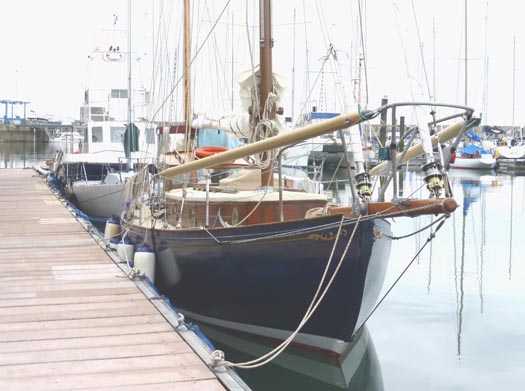
"Maritime museum" at the Royal Irish YC. Ainmara (built Ringsend 1912) with the 1987 Quarter Tonner Quest astern, and the 1966-built S&S 36 Sarnia across the way in her marina berth. Photo: W M Nixon
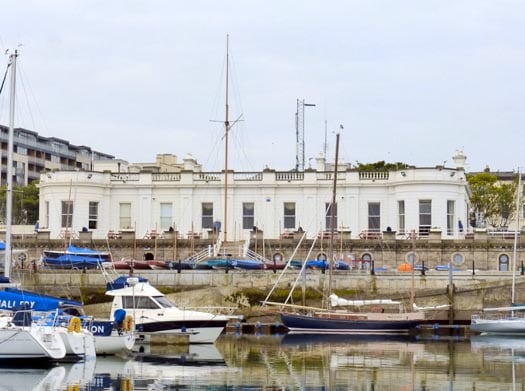
It has to be one of the best berths in the world. Ainmara at the RIYC – it's early morning, and the flags aren't yet hoisted. Photo: W M Nixon
The hospitality flowed seamlessly as the late afternoon graduated into evening and then velvet night. Ainmara is an extraordinarily effective calling card, and the stream of entertaining visitors brought laughter aboard before the Commodore moved us all up to the clubhouse and a fine supper and much chat with Michael O'Leary, one of the most visionary minds in Irish sailing, and his wife Kate and her people with tales of how she and longtime friend Clare Hogan are in the thick of things in the very healthy Water Wag class.
The RIYC took all this in its stride despite the fact that there was a big wedding going in the clubhouse at the same time, but it all went so smoothly that at one stage Ainmara's crew found themselves being invited to join in the wedding celebrations. However, we demurred because we were athletes in training for the Leinster Trophy next day, yet nevertheless certain key players in the wedding got themselves aboard Ainmara at a very late hour.
The plan for Saturday had been changed, but we were right up to speed with this as Denis Aylmer, the RIYC's key man in the OGA, had told us over a convivial pint that the likelihood of light winds had meant that Race Officer John Alvey had moved the scene of the action from Scotsmans Bay to a more compact race area close off the entrance to Dublin Port. It was all grist to our mill, as we could make an early morning departure and head up to Poolbeg Y & BC across a mirror-like bay, lining up the crew to salute the North Bank Lighthouse in the River Liffey, as it's something of a memorial to John B Kearney, whose day job was in the engineering department in Dublin Port and docks. With his original lighthouse, he pioneering a technique of screwing the piles into the seabed. You'd have thought an air of reverence would prevail, but with Ainmara's crew of anarchists, straight faces could only be maintained for about 12 seconds.
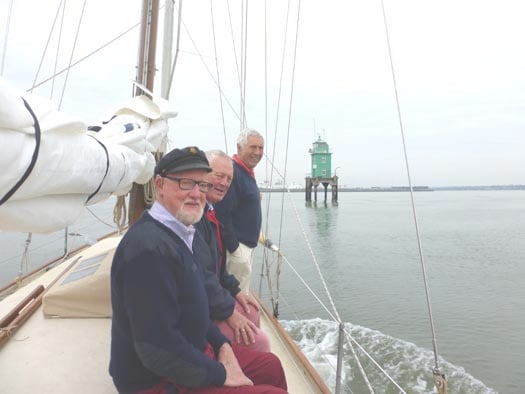
Trying to look appropriately reverential. Ed Wheeler, Brian Law and Dickie Gomes approaching Dublin Port's North Bank Lighthouse on which John B Kearney pioneered the use of screw piles. Photo: W M Nixon

"We're only here for the breakfast". Katy O'Connor's excellent catering in Poolbeg Y & BC is deservedly popular among visiting crews. Photo: W M Nixon
While we wanted to be well on time for the pre-race briefing, the main reason for getting promptly to Poolbeg was to take full advantage of Katy O'Connor's legendary breakfast at the club, and we put away enough calories to keep us going all day. At the briefing, John Alvey told us the committee were concerned that the very varied fleet – everything from Ainmara to the big Naomh Cronan, a superb Clondalkin-built re-creation of a Galway Hooker – included some boats which, in the light airs expected, could be out on the bay until nightfall.
So the plan was for a short race taking in several marks so that it could be finished at the end of any leg. But by the time we got down to Dublin Bay, it was crisp blue with a smart little sea breeze filling in to give sailing conditions which suited Ainmara to perfection, yet some of the heavier gaffers were still lumbering slowly about in what to them was a light wind.
They may have been lumbering about, but several were very determined to make a sharp start right on the committee boat. Anyone accustomed to quick-turning and fast-accelerating modern boats will find a fleet of traditional and classic gaffers a real education. They take time to get moving, they take for ever to stop, you point them a long way out, and their bowsprits – "dock probes" as marina managers call them – seem intent on skewering everyone else.
But while our skipper may pretend to be just an old cruising man these days, his racing blood was up. We set ourselves to sweep into what we hoped would be a gap starting to appear at the committee boat seconds after the start signal. We consoled ourselves with the thought that in extremis, we might just manage to shoot head to wind leaving the committee boat to port, ruining our start perhaps, but preserving the Ainmara intact.
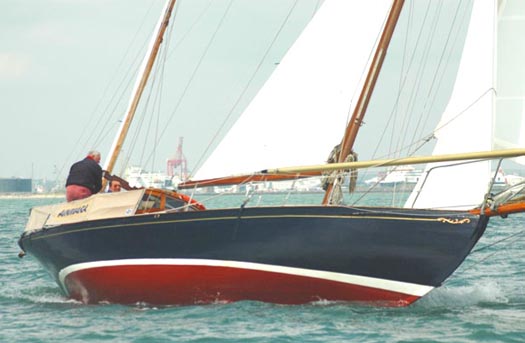
"Go for it, and let's hope there's a gap when we get there..." Ainmara starts to build speed towards her start in the Leinster Trophy Race 2014 . Photo: Gill Mills
So she was set at it, despite attempts to slow her a bit the speed built up, but as quickly as I'm telling this the gap started to appear and she zapped into it and just managed to keep her wind clear on Sean Walsh's remarkably fast Heard 28 Tir na nOg and Denis Aylmer's Mona. Now we had to find the DBSC marks in the right sequence, but Ed was on top of it feeding co-ordinates and giving out courses, we found that with a bit of luck we might just lay the first mark close hauled, and though Tir na nOg – whose waterline length is much the same as Ainmara's – hung in very well, he'd to tack for the mark while we scraped by it, so after that it was up jib tops'l and making hay.
But though we took line honours, we felt certain Tir na nOg would win on corrected time, as a Heard 28 sailed as well as she is can be one very potent performer, and Sean seemd to be still right on our stern at the finish. The results wouldn't be announced until Monday evening, so that Saturday afternoon we wandered back upriver to Poolbeg in sunshine so powerful that an afternoon zizz was your only man, and then we emerged on deck to find that others were arriving in port, with one of the the Welsh visitors, the engine-less Happy Quest from Milford Haven, making a copy-book job of berthing under sail, and then all was alive with the Howth Seventeens arriving in from their home port after a very close-fought passage race which had been narrowly won by Conor Turvey sailing Isobel.

Happy Quest from southwest Wales lives up to her name with a successful berthing under sail only at Poolbeg. Photo: W M Nixon
The Seventeens were there to put on a display race next day (Sunday) in the Liffey as part of the three day Dublin Port Riverfest over the Bank Holiday weekend. Inevitably for those of us who took part in the first one in 2013 when the OGA Golden Jubilee was top of the bill, there wasn't quite the same buzz, but first-timers watching aboard the restaurant ship Cill Airne assured us they found it very exciting indeed, and were especially impressed by the waterborne ballet of the two big harbour tugs Shackleton and Beaufort, while the funfairs and entertainment shows along the quays really did provide something for everything.
Once again the very sight of the Seventeens – which we in Howth tend to take for granted – was fascinating in the city setting. Though the promise of a decent breeze evaporated, Race Officer Harry Gallagher managed to get enough in the way of results to declare Peter Courtney with Oonagh the winner, an appropriate result for an historic class making a show performance, as the Courtneys have been involved with the Howth Seventeens since 1907.
I watched it all from an appropriate setting, aboard the Dutch Tall Ship Morgenster, a handsome 150ft brig which should be required visiting for anyone promoting the idea of a new Tall Ship for Ireland. For the Morgenster – which was re-configured as a sailing ship in 2009 – is run as a commercial venture, and can pay her way through being the right size to be a business proposition, helped by being based in the Netherlands. Thus she has a vast continental catchment area nearby to attract trainees of all ages and abilities who are prepared to pay enough for berths to keep the show efficiently on the road. There are several Dutch-based tall ships run in the same way, and the message is that if you're going to make a go of it commercially, you have to have a large enough and readily-accessed market to make it viable, and you need a boat big enough to carry sufficient trainees relative to the size of the ship – 36 in Morgenster's case – to balance the books.
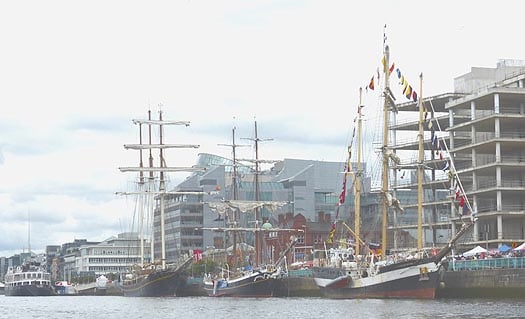
Tall ships in the Liffey, with the commercially-run 150ft sail training big Morgenster at centre. Photo: W M Nixon
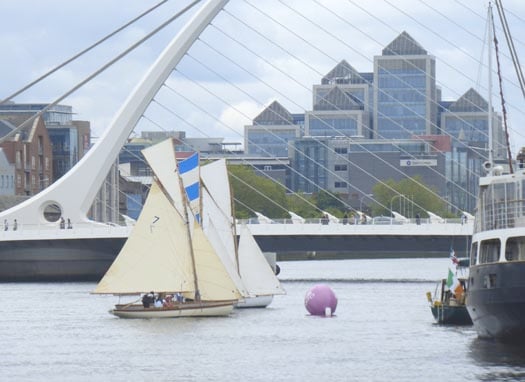
Sails and the city – Howth 17s at the Sam Beckett bridge Photo: W M Nixon
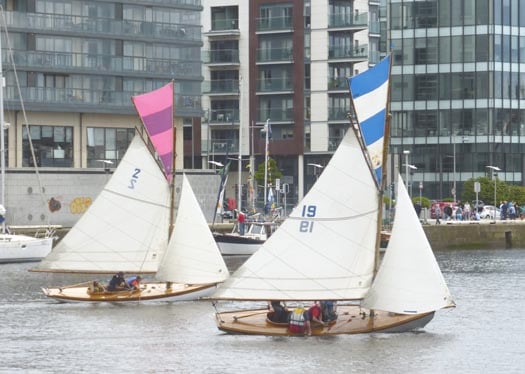
There was just enough wind for the first race for the Howth 17s to show what they could do in the Liffey if the breeze held up. Photo: W M Nixon
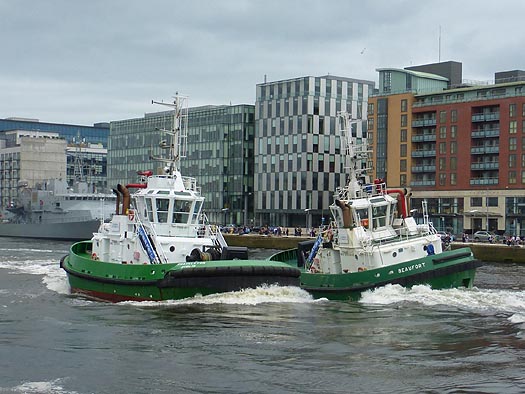
The Dublin Port tugs have awesome power to deploy in their waterborne "ballet" Photo: W M Nixon
But enough of solemnity. We went downriver again for farewells at Poolbeg, and then away across Dublin Bay and round the Baily for a seafood feast in Howth at the new place Crabby Jo's, and a handy overnight stop before using a good westerly next morning to give us a push towards Ardglass where we needs must stop, as the tides into Strangford Lough are a door slammed shut every six hours. But as ever, Ardglass's convenient and friendly little marina provided the perfect decompression chamber, and up in Mulherron's the crack was mighty with the crew of the famous restored Manx longliner Master Frank, just the two of them with skipper Joe Pennington - aka The Rat – being crewed by a psychiatrist who claimed to be strictly on holiday, but we did wonder, as any gathering of Old Gaffers is better than a wardful of nutters.
Ainmara's mini-voyage concluded next day with a text message from Dublin to tell us we'd retained the Leinster Trophy, which surprised us, and then with an idyllic sail in a sunny sou'wester, everything set to the jib tops'l, and all sail carried right through The Narrows, across Strangford Lough and thorough Ringhaddy Sound, and on across a blue sea among green islands past tree covered shores until we handed the sails just off the entrance to Down Cruising Club's isle-girt outer anchorage immediately south of Mahee Island, in a little sheltered area which has somehow acquired the unlovely name of Pongo Bay.

Home again. Ainmara back on her mooring in Strangford Lough, with Brian Law's classic yawl Twilight astern. Photo: W M Nixon
There, Ainmara is securely moored close to Brian Law's own cruising boat, the beautifully restored classic Lion Class yawl Twilight, designed by Arthur Robb. Like Dickie Gomes, Brian does all his own boatwork in a hayshed beside the house. So closely intertwined are their interests that they readily crew for each other, and of course the exchange of information and assistance and re-fit ideas is continuous.
And there's one further fact about these guys which may be of interest to other cruising crews. Aboard Ainmara during the three seasons in which I've cruised on her since she was restored for her Centenary in 1912, there's no kitty to cover expenses. There's an underlying feeling that as the skipper provides the boat, the crew owe him on a permanent basis. Thus if we get into a port and there's a choice between a comfortable marina berth or hanging off a quay wall, the crew will simply slip away and discreetly pay for a marina berth, and then tell the skipper it's a done deal.
Equally, when ashore for a meal, one of the crew will usually sidle off and pay for everyone when no-one else is looking. But if the skipper thinks the day has gone particularly well, you'll sometimes find he's paid for it all himself, As for getting diesel, whoever is carrying the cans will pay for it himself. Then too, when stores are required, it's covered by whoever goes to get them. It all sounds like an accountant's nightmare, yet so far, somehow at the end of the cruise everyone is content with the feeling that it has all balanced out, and as it has worked well for three years and longer, the attitude is that if it ain't broke, then don't try and fix it.
It had been hoped that Ainmara could stay on in the Dublin area for a week to do the Howth YC's Lambay Race in the Old Gaffers division on June 7th, as she won it in 1921. However, there was too much work still to be done to get her completely ready for a busy cruise programme coming rapidly down the line. But as she'll have to be back next year to defend the Leinster Trophy again, who knows but the double event might be done in 2015. As it was, her need for further fitting-out nearer to home was the saving of me, as a mighy temptation arose. The ancient Madcap from the north had stayed on in Dublin Bay, and was doing the Lambay Race with other old gaffers. The word on the waterfront is that Madcap may well be sold to France to be the centrepiece of a maritime museum in La Rochelle. So the Lambay Race might well be the last chance to sail on a 140-year-old boat. A place was secured on board.

The gaffers gather......Tir na nOg, Madcap and Naomh Cronan on misty morning in Howth before the Lambay Race. Photo: W M Nixon
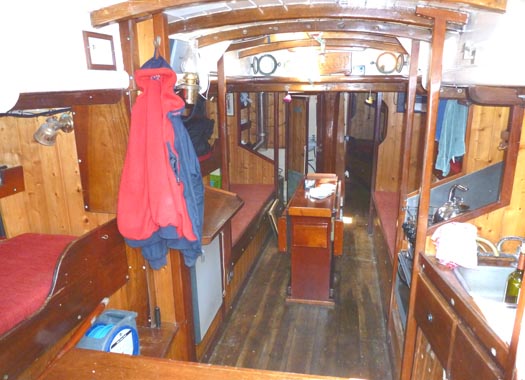
Madcap's sensible accommodation (above and below) reflects the seagoing needs of the pilots for whom she was built140 years ago. Photo: W M Nixon
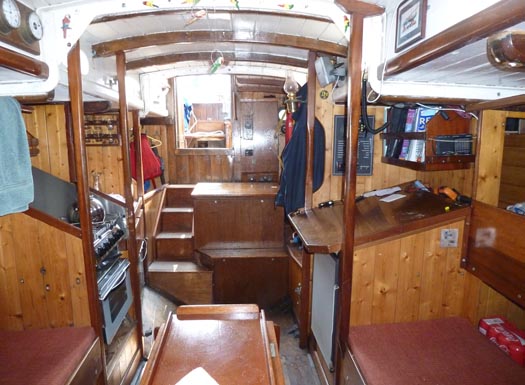
Madcap's owner for more than twenty years now has been Adrian "Stu" Spence, a rugged Belfast barrister who has the essential determination to keep such an ancient boat going. And going places too – he has been to Greenland and several times to Spain and Brittany, and has brought his old cutter through many a problem to log an impressive voyaging record.
If you have a boat of this age, your motto is: When God made time, he made a lot of it. Thus although the Old Gaffer's division was due to start at 1135, five minutes after the Howth Seventeens had set off through Howth Sound to sail the traditional Lambay course leaving Ireland's Eye to starboard and Lambay to port in order to celebrate the centenary of the Lynch family's Howth 17 Echo, it was pushing 1140 by the time we mde our leisurely debut to follow other other gaffers, which had Sean Walsh's keenly-sailed Tir na nOg soon disappearing into the misty asterly, followed by the Galway hooker Naomh Cronan helmed by the great Paddy Murphy of Renvyle, the Cornish crabber Alice (Mark Lynch) and then Madcp in her own good time.
With Northern Ireland Old Gaffers Association President Peter Chambers on the helm, Madcap settled gently into her stride, showing that she needs very little steering – she'll maintain a straight line for miles without the wheel being touched or secured in a any way. It's an oddly soothing characteristic, just the thing to calm a man down after a hectic week in the High Court, and she soon was making her own best speed with a bit of bite now in the breeze, putting Alice astern and keeping Naomh Cronan handily in touch.

"Is it always this foggy off Howth?" Stu Spence and Peter Chambers with he visibility closing in during the Lambay Race. Photo: W M Nixon
The mist became fog, but as ever it was difficult to tell just how thick it was until we suddenly found ourselves surrounded by wraiths in the gloom. It was Class 0 racing towards Lambay, and overtaking us just feet away, giving dramatic close-ups of some of the most likeable boats on the East Coast, with Stephen O'Flaherty's Spirit 54 Soufriere pacing it with Chris Hourican's First 47.7 Pretty Polly and the Tyrrell family from Arklow with their handsome J/122 Aquelina.
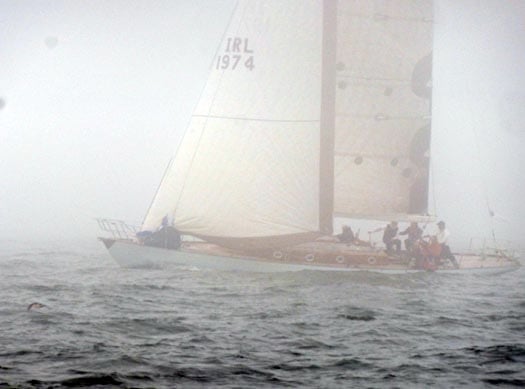
Do not adjust your sets, it really was this foggy for a while. Stephen O'Flaherty's Spirit 54 Soufriere in the fog during the Lambay Race Photo: W M Nixon

Chris Hourican's First 47.7 Pretty Polly in close-up Photo: W M Nixon
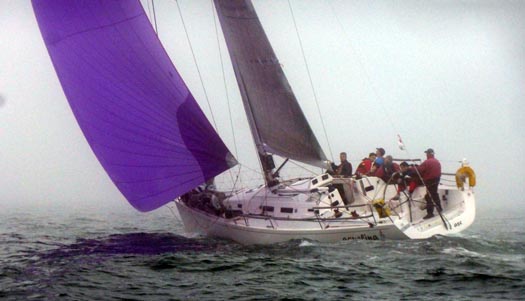
The Tyrrell family's J/122 Aquelina looking her best as she slices through the fog. Photo: W M Nixon
The fog was lifting as we got to the island with boats everywhere – the gaffermen were most impressed. Naomh Croanan had been overtaken, and Peter found us the perfect track along the flukey north side of Lambay, with Madcap effortlessly sliding over the smooth sea on a dead run and apparently consolidating her position.
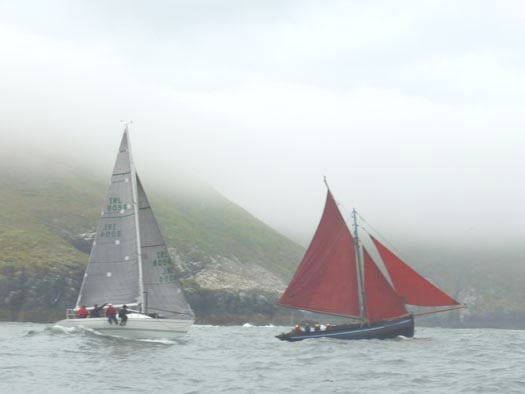
The fog start to lift. Dave Cullen's Half Tonner King One and te Naomh Cronan pproaching the east point of Lambay. Photo: W M Nixon
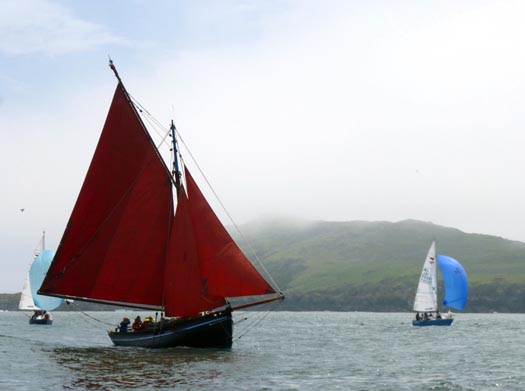
It could be Connemara...., .Naomh Cronan and two Puppeteer 22s off the north coast of Lambay Photo: W M Nixon

The long haul to the finish, the sun is out, and the breeze is beginning to develop enough power to suit Madcap. Photo: W M Nixon
But that was only until we started to head south back to the finish in Howth Sound. The Bermudan boats could lay it, so could the Seventeens, but poor old Madcap was even outpointed by Naomh Cronan, which Paddy Murphy very skilfully kept inside the line of foul tide in Lambay Sound and began to nibble at our lead, while we sagged to lee.
The sun was out, the sailing was lovely, we were surrounded by bustling classes of Puppeteer 22s and Ruffians 23s, and I suggested that a bit more tension in the jib luff, might do the trick, only to be told that as the bowsprit was no more than a liberated telegraph pole, it wasn't really up to the loads which would be put on it by trying to maximise the performance of a 22-ton boat, and nobody wanted splinters flying every which way aboard a boat where the mainboom looked to weigh at least half a ton.
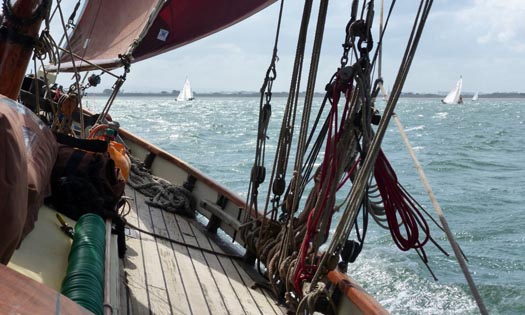
A bite to the breeze, with little boats everywhere – and all of them on starboard. Photo: W M Nixon

The Dun Laoghaire Ruffian 23s made a weekend of it for the Lambay Race, coming over on the Friday night, partying mightily, and then going out to race on Saturday in a rising breeze. Photo: W M Nixon
As it is the loads becme quite something as the breeze freshened sunny and squally down the north flank of the hjill of Howth. By the time we made it across the line, Madcap was going well on smooth water under just mainsail and staysail. But though Naomh Cronan was still ahead and rightly delighted with themselves at getting a good second, it was Tir na nOg which had been in race of her own. Yet as Sean Walsh reported with astonishment, he hadn't been able to get among the slippy little Howth 17s, where John Curley and Marcus Lynch had a good win with Rita, Howth Seventeen No. 1.
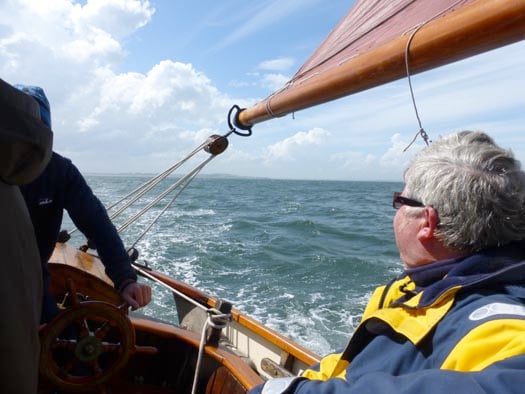
Finally there was enough breeze for Madcap's wake to stretch satisfyingly astern while she could point better with the jib brought in, but Naomh Cronan still finished ahead to take second prize. Photo: W M Nixon

The mighty helmsman of Renvyle. Paddy Murphy (left) steered Naomh Cronan to an excellent performance in the Lambay Race 2014. With him is DBOGA Hon Sec Gerry Murtagh with a trophy he won racing round Lambay in 1986. Photo: W M Nixon
It seemed an Old Gaffers Classic Lambay Race had been inaugurated, and Sean Walsh, international President of the OGA, was most appropriately the first winner. It was something to celebrate, and it duly was, in the sunshine at Howth YC. But in time, I had to take myself away and go for a long walk with the little dog along the beach. For when you've been sailing on a 140-year-old boat, there's a need to ponder the passing years, and this crazy sport of ours in which museum pieces are part of the action.
#RACING ROUND–UP – Ireland's Star pair Peter O'Leary and David Burrows are in the frame at the Star worlds in Hyeres this morning having held the lead after thie first two races, James Espey is Olympic bound in his Laser dinghy following qualification in Germany last night, Alexander Rumball and Rory McStay are joining the Irish ISAF Youth Worlds squad as Ireland's first Catamaran pairing, Offshore J109s continue to dominate on the Irish Sea and ICRA is still seeking support to mount a defence of its 2010 Commodore's Cup victory.
Kinsale's Marcus Hutchinson won the South Coast Squibs, JP McCaldin was on form at the J24 Easterns in Howth, Derek Mitchell was top in Saturday's DBSC Ruffian race, Foynes Yacht Club cruised to Limerick and Andrew Algeo emerged a winner in a class that have changed much more than their racing format.
Kirwan's Ruff'n'Ready to the Fore on Dublin Bay
July's last Dublin Bay Sailing Club race on Saturday produced a win for Ann Kirwan's Ruff''n'Ready in the Ruffian class. Second was Michael Cutliffe's Ruffles and third Derek Mitchell's Derek Mitchell. Full results for the DUBLIN PORT Dublin Bay Sailing Club Results for 30 JULY 2011 here:
BENETEAU 31.7 Echo - 1. Attitude (D.Owens/T.Milner), 2. Levante (B.Leyden/M.Leahy), 3. Bluefin Two (M & B Bryson)
BENETEAU 31.7 - 1. Bluefin Two (M & B Bryson), 2. Levante (B.Leyden/M.Leahy), 3. Attitude (D.Owens/T.Milner)
CRUISERS 0 Echo - 1. Tsunami (Vincent Farrell)
CRUISERS 0 - 1. Wow (George Sisk), 2. Tsunami (Vincent Farrell)
CRUISERS 1 Echo - 1. Jump The Gun (M.Monaghan/J.Kelly), 2. Xtravagance (Colin Byrne), 3. Gringo (Tony Fox)
CRUISERS 1 - 1. Xtravagance (Colin Byrne), 2. Gringo (Tony Fox), 3. Something Else (J.Hall et al)
CRUISERS 2 Echo - 1. Peridot (Jim McCann et al), 2. Graduate (D O'Keeffe), 3. Helter Skelter (Adrienne Jermyn)
CRUISERS 2 - 1. Peridot (Jim McCann et al)
CRUISERS 3 Echo - 1. Papytoo (M.Walsh/F.Guilfoyle), 2. Carrabeg (D.Martin/R.Deasy), 3. Asterix (Counihan/Meredith/Bushell)
CRUISERS 3 - 1. Supernova (K.Lawless et al), 2. Asterix (Counihan/Meredith/Bushell), 3. Papytoo (M.Walsh/F.Guilfoyle)
DRAGON - 1. Zu (P.Dee et al)
FLYING FIFTEEN - 1. Gekko (S & P Nolan), 2. The Last Resort (John O'Sullivan), 3. Gulfstream (A.Cooper)
GLEN - 1. Glenshesk (L.Faulkner et al), 2. Glenroan (Terence Moran), 3. Glencorel (B.Waldock/K.Malcolm)
RUFFIAN 23 - 1. Ruff N Ready (Ann Kirwan et al), 2. Ruffles (Michael Cutliffe), 3. Ruff Nuff (D & C Mitchell)
SHIPMAN - 1. Bluefin (B.Finucane et al), 2. Macro One (Joseph Murray), 3. Curraglas (John Masterson)
SIGMA 33 - 1. White Mischief (Timothy Goodbody), 2. Gwili Two (D.Clarke/P.Maguire), 3. Moonshine (R.Moloney/D.O'Flynn)
WHITE SAIL CRUISERS Echo - 1. Calypso (Howard Knott), 2. Spirit (Colin O'Brien et al), 3. Xerxes (Dan O'Neill)
WHITE SAIL CRUISERS - 1. Calypso (Howard Knott), 2. Act Two (Michael O'Leary et al), 3. Zephyr (R Cahill-O'Brien)
Racing Round Up - Weekend Irish Sailing Review
Diane II Races to Ruffian Success on Dublin Bay
Taking the Ruffian prize at Volvo Dun Laoghaire Regatta two weeks ago, Class vice-captain Alan Claffey sailing Diane II added the national title yesterday after a three day series on Dublin Bay. SCROLL DOWN FOR PHOTOS BY GARETH CRAIG.
The championship, hosted by the National Yacht Club, was sailed in light airs, and featured 20 boats, including three boats from Carrickfergus and two from Skerries.
After 2 days, "Carrigeen" from Carrickfergus was leading Diane II by 2 points, but Claffey took two guns on the final day to clinch the championship.
Carrigeen was second and Siamsa from Skerries was third.
Ruffiian Alias Rises to the Challenge on Dublin Bay
BENETEAU 31.7 - 1. Attitude (D.Owens/T.Milner), 2. Extreme Reality (P.McSwiney/E.O'Rafferty), 3. Magic (D.O'Sullivan/D.Espey)
BENETEAU 31.7 - 1. Magic (D.O'Sullivan/D.Espey), 2. Attitude (D.Owens/T.Milner), 3. Extreme Reality (P.McSwiney/E.O'Rafferty)
CRUISERS 2 - 1. Cor Baby (Keith Kiernan et al)
CRUISERS 3 - 1. Chouskikou (R.Sheehan/R.Hickey), 2. Papytoo (M.Walsh/F.Guilfoyle), 3. Pamafe (Michael Costello)
Ensign - 1. NYC 2 (Helen Cooney), 2. NYC 1 (Olivier Prouveur), 3. RIYC 2 (Mark McGibney)
FIREBALL - 1. nn (S Oram), 2. Blind Squirrel (Frank Miller), 3. Elevation (N.Colin/M.Casey)
GLEN - 1. Pterodactyl (R & D McCaffrey), 2. Glenshane (P Hogan), 3. Glencoe (Rose Mary Craig et al)
IDRA 14 FOOT - 1. Squalls (Stephen Harrison), 2. Dunmoanin (Frank Hamilton), 3. Sapphire (Lorcan O'Sullivan)
MERMAID - 1. Jill (P.Smith/P.Mangan), 2. Lively Lady (G O'Neill & M Hanney), 3. Tiller Girl (J.O'Rourke)
PY CLASS - 1. Evan Dolan (), 2. C Arrowsmith (Laser), 3. Gary O'Hare (Laser)
RUFFIAN 23 - 1. Alias (D.Meeke/M.McCarthy), 2. Diane ll (Bruce Carswell), 3. Cresendo (L Balfe)
SIGMA 33 - 1. September Song (Conor Colleary), 2. Pippa lV (G.Kinsman/K.Blake/M.O'Brien), 3. Pastiche (John Peart et al)





























